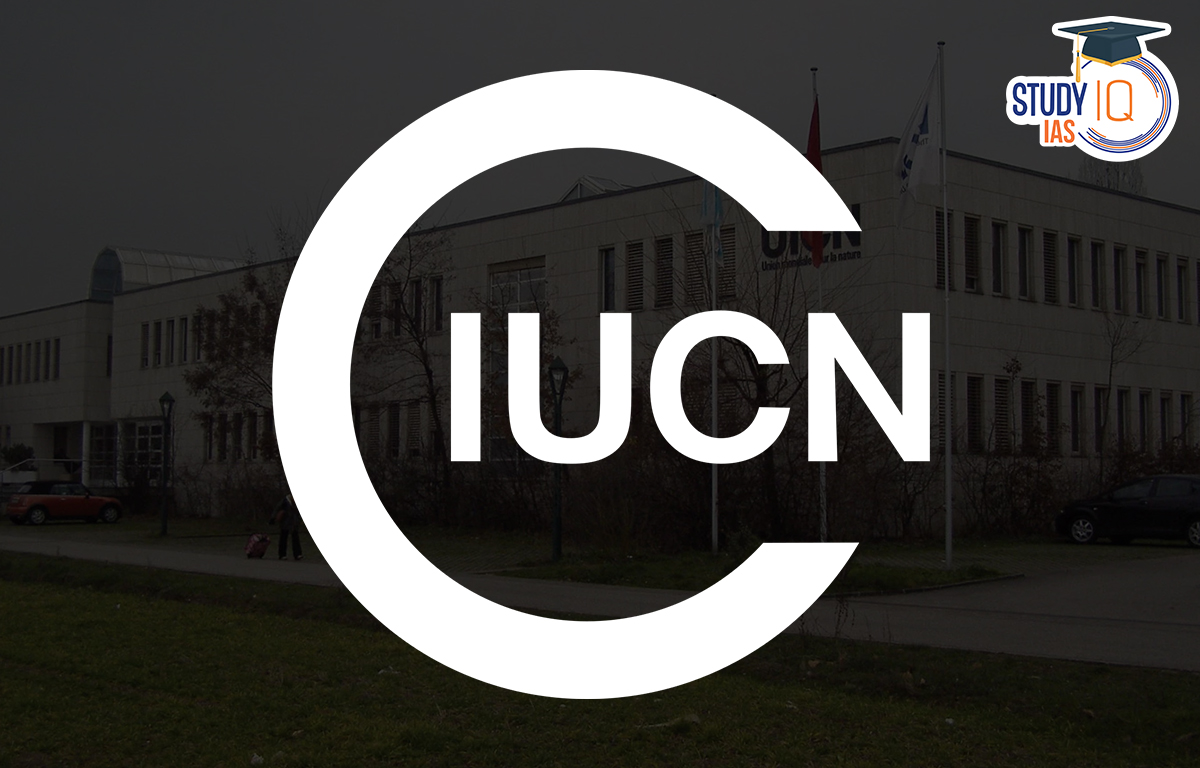Table of Contents
IUCN
A worldwide organisation called the International Union for Conservation of Nature (IUCN) was founded in 1948. It is the largest and most diverse environmental network in the world, made up of governmental and non-governmental organisations as well as international scientists.
The IUCN’s objective is to support the preservation and sustainable use of natural resources and to give governments, non-governmental organisations, and the general public access to scientific knowledge and advice. The group strives to create and carry out conservation policies, programmes, and projects as well as to spread knowledge of environmental problems and their effects on people and the environment.
The Red List of Endangered Species, which is the most thorough inventory of the conservation status of species worldwide, is the IUCN’s claim to fame. The topic of IUCN holds immense importance for the UPSC Syllabus and a detailed account of IUCN is given below.
IUCN Headquarters
In Gland, Switzerland is where the International Union for Conservation of Nature (IUCN) is headquartered. The “Chateau de Bellevue,” the IUCN’s administrative facility, with a view of Lake Geneva.
Regional offices for the IUCN are located in Africa, Asia, Europe, Oceania, and the Americas, among other locations. These offices assist conservation initiatives in their respective regions as well as the regional and local implementation of the organization’s programmes and initiatives.
The IUCN has many expert groups and commissions that concentrate on particular conservation topics, such as the Species Survival Commission and the World Commission on Protected Areas, in addition to its headquarters and regional offices.
IUCN Establishment
The International Union for Conservation of Nature (IUCN) was established in October 1948 in Fontainebleau, France. The organization was founded as the International Union for the Protection of Nature (IUPN) by a group of scientists, government officials, and conservationists who recognized the need for a coordinated global effort to protect the natural world.
The IUPN’s founders were inspired by the success of the Migratory Bird Treaty Act of 1918, which had helped to protect bird populations in North America, and by the establishment of national parks and other protected areas around the world. They believed that by working together, they could develop more effective strategies for conservation and make a greater impact in protecting the Earth’s natural resources.
The IUPN’s early activities focused on the protection of wildlife and the establishment of national parks and other protected areas. In the years that followed, the organization expanded its focus to include a wide range of environmental issues, including climate change, biodiversity conservation, and sustainable development.
In 1980, the organization adopted its current name, the International Union for Conservation of Nature, to reflect its expanded mission and focus on the conservation and sustainable use of natural resources. Today, the IUCN is the world’s largest and most diverse environmental network, with over 1,400 member organizations and more than 17,000 experts and scientists from around the world.
International Union for Conservation of Nature (IUCN) History
The International Union for Conservation of Nature (IUCN) was founded in 1948 in Fontainebleau, France, as the International Union for the Protection of Nature (IUPN). The organization was created to bring together governments, non-governmental organizations, scientists, and other stakeholders to promote the conservation and sustainable use of natural resources.
Over the years, the IUCN has played a key role in shaping international conservation policy and promoting global cooperation on environmental issues. In the 1960s, the organization helped establish the United Nations Environment Programme (UNEP), and in the 1970s, it played a leading role in the development of the Convention on International Trade in Endangered Species of Wild Fauna and Flora (CITES).
In 1980, the IUCN adopted its current name to reflect its expanded mission and focus on the conservation and sustainable use of natural resources. In the years that followed, the organization continued to play an important role in global environmental policy, including the development of the Convention on Biological Diversity (CBD) in 1992.
Today, the IUCN is the world’s largest and most diverse environmental network, with over 1,400 member organizations and more than 17,000 experts and scientists from around the world. The organization works on a wide range of conservation issues, including biodiversity conservation, climate change, and sustainable development, and is widely recognized as a leading authority on environmental issues.
IUCN Red List
The IUCN Red List of Threatened Species is a global assessment of the conservation status of plant and animal species, subspecies, and varieties. The Red List is maintained by the International Union for Conservation of Nature (IUCN) and is widely recognized as the most comprehensive and authoritative source of information on the conservation status of species.
The Red List uses a set of criteria to assess the risk of extinction faced by a species. The criteria take into account a range of factors, including population size and trend, geographic range, habitat loss and fragmentation, and other threats such as climate change and overexploitation.
IUCN Red List Categories
The International Union for Conservation of Nature (IUCN) has developed a set of categories and criteria for classifying the conservation status of species, ecosystems, and other natural resources. These categories are known as the IUCN Red List Categories, and they are widely used by scientists, conservationists, and policy-makers around the world to assess and prioritize conservation efforts.
The IUCN Red List Categories are as follows:
- Extinct (EX): A taxon is considered extinct when there is no reasonable doubt that the last individual has died.
- Extinct in the Wild (EW): A taxon is considered extinct in the wild when it is known only to survive in cultivation, in captivity or as a naturalized population (or populations) well outside the past range.
- Critically Endangered (CR): A taxon is considered critically endangered when it faces an extremely high risk of extinction in the wild.
- Endangered (EN): A taxon is considered endangered when it faces a very high risk of extinction in the wild.
- Vulnerable (VU): A taxon is considered vulnerable when it faces a high risk of extinction in the wild.
- Near Threatened (NT): A taxon is considered near threatened when it is close to qualifying for or is likely to qualify for a threatened category in the near future.
- Least Concern (LC): A taxon is considered the least concern when it does not qualify for a threatened category.
- Data Deficient (DD): When there is insufficient knowledge to determine a taxon’s risk of extinction, it is deemed to have data deficiencies.
IUCN Red Data Book
These categories provide a standardized framework for assessing the conservation status of species and ecosystems, and for prioritizing conservation efforts to ensure that the most vulnerable and endangered resources receive the most attention and protection.
The IUCN Red Data Book is a predecessor of the current IUCN Red List of Threatened Species. The Red Data Book was first published in 1964 and served as a global list of endangered and vulnerable species. It was compiled by the International Union for Conservation of Nature (IUCN) and contained information on a wide range of plant and animal species from around the world.
The Red Data Book aimed to provide a comprehensive overview of the conservation status of species and to raise awareness about the threats facing them. It used a similar set of categories to the current Red List, with species classified as extinct, endangered, vulnerable, rare, indeterminate, or insufficiently known.
Over time, the Red Data Book evolved and was replaced by the IUCN Red List of Threatened Species in the 1990s. The Red List uses a more standardized and rigorous approach to species assessment, based on a set of criteria and guidelines that have been developed and refined over many years.
While the Red Data Book is no longer in use, it played an important role in early conservation efforts and helped to raise awareness about the need for species protection. Many of the species listed in the Red Data Book continue to be of conservation concern today, and their inclusion in the book contributed to efforts to protect and conserve them.
IUCN UPSC
The International Union for Conservation of Nature (IUCN) is an important organization from an environmental and conservation perspective and therefore is relevant for the UPSC (Union Public Service Commission) exam in India. The IUCN is a global organization that works on conservation issues and is involved in research, advocacy, and policy development related to biodiversity and ecosystem conservation.
The UPSC exam often includes questions related to environmental and conservation issues, and the IUCN is a key player in these areas. Questions may include topics such as the IUCN Red List, conservation strategies, sustainable development, and the role of NGOs in conservation efforts.
It is therefore important for UPSC aspirants to have a good understanding of the IUCN’s history, mission, and activities, as well as the organization’s role in global conservation efforts. Studying the IUCN’s Red List categories and criteria, as well as its initiatives in biodiversity conservation and sustainable development can also be helpful for aspirants preparing for the exam.
Students can go for UPSC Mock Test to enhance their preparations for their upcoming IAS Prelims examination. Mocks help to score well in the exam. For more details related to UPSC Examination; students can visit the official website of StudyIQ UPSC Online Coaching. Aspirants can improve their question-solving skills by solving mock on a weekly basis.


 Daily Quiz 01 July 2025
Daily Quiz 01 July 2025
 China, Pakistan and Bangladesh Trilatera...
China, Pakistan and Bangladesh Trilatera...
 US Pulls Funding from GAVI-Global Vaccin...
US Pulls Funding from GAVI-Global Vaccin...





















